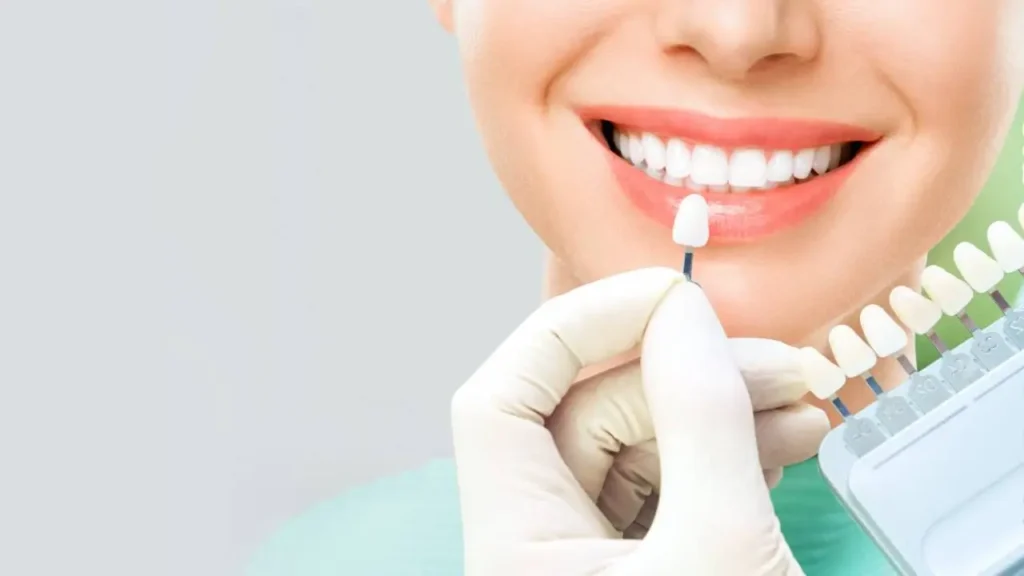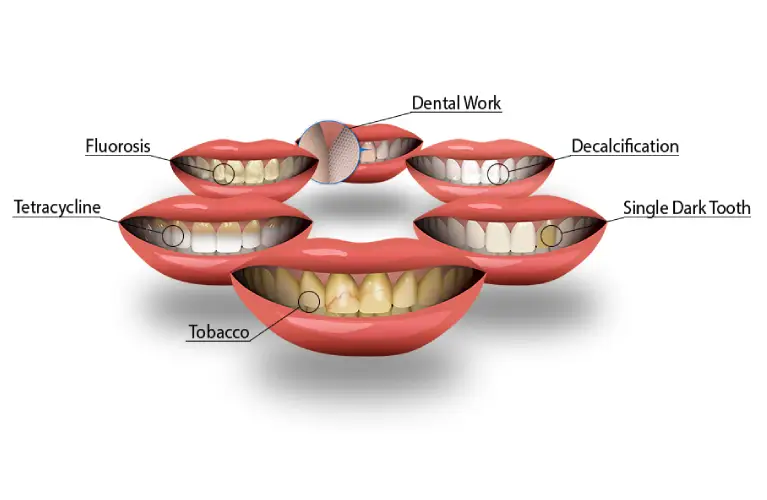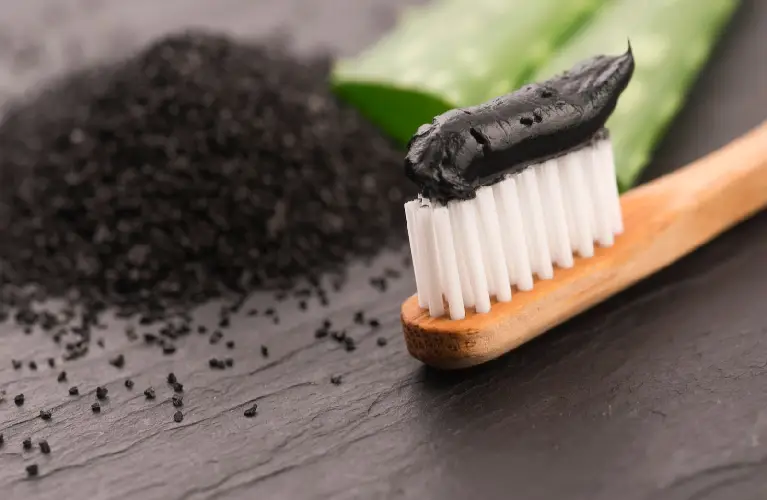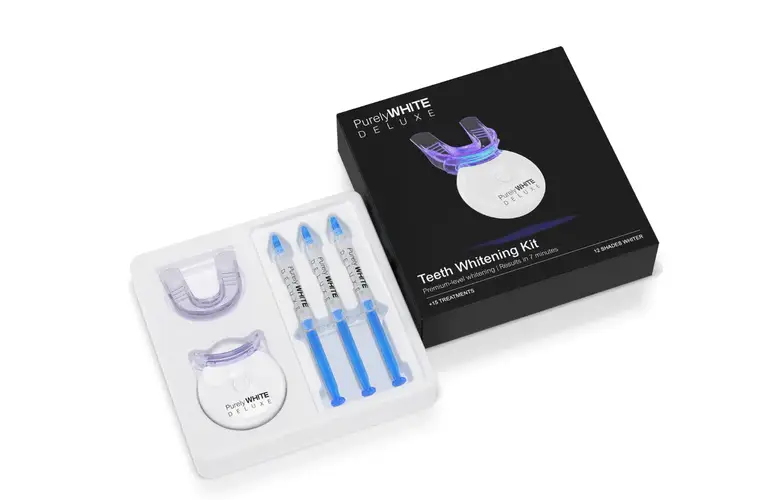Teeth Whitening | Smile Makeover – Aries Oro-Facial Dental Clinic | Vadodara

Risks of Teeth Whitening: What You Need to Know Before Getting Started | Teeth Whitening in Vadodara

White teeth are an extremely popular cosmetic dental treatment that can make your teeth appear whiter and improve your appearance. However, like many dental procedures, teeth whitening is also risky.
The side effect is mild and can involve teeth sensitivity or gum irritation. When getting your front teeth whitened or whiter, you need a talk to your dentist to explain your potential risks. Read the following information for a more accurate decision. This oral treatment will brighten up your teeth and brighten them.
Bleaching vs Whitening: What’s the Difference? | Teeth Whitening In Vadodara
A new FDA rule allows the use of the word “bleaching” only when the teeth are whiter than the teeth’ natural hue. These are primarily products containing hydrogen peroxide and carbamide peroxides
In contrast, whitening teeth refers to professional products for the cleaning and restoration of the teeth surfaces by cleaning off dirt from tooth surface, stains and debris from them. Technically speaking, all products for whitening teeth and washing like toothpaste are classified as white. It’s true that the word for whitening solution is more effective than teeth whitening options and is used more often when using products that contain bleach.
Tooth Discoloration: Extrinsic vs. Intrinsic Staining
In teeth and tooth staining there are three different types: intrinsic and extrinsic.

Extrinsic Tooth Stain
Occur when teeth begin exposed to dark-colored foods or alcohol and routine wear. Superficial extrinsic spots that stain teeth can be removed using sweeping and prophylaxis tooth whitening methods. Stubborn external to stain teeth; stain removal is possible with less involved efforts such as dental whitening.
Persistent extrinsic stains can enter the dentin if ignored in advance. Intrinsic stains occur inside a tooth’s surface.
What Causes Tooth Staining?
It is very likely that teeth color will correlate with age. By the early 60s teeth had accumulated many stains which were difficult to remove tooth stains from from (if not impossible to remove stains from sensitive teeth) in cleaning. Starting Color: We have an innate first tooth color for teeth ranging from yellow-brown to greenish brown and intensifying tooth color at various levels of age.
There are reasons why your teeth can become discolored or stained over time. These include:
- Drinking coffee, tea, red wine, or sodas
- Smoking cigarettes or using other tobacco products
- Eating certain foods (such as blueberries)
- Taking certain medications (such as tetracycline)
- Not taking proper care of your teeth
- Aging
What are Your Whitening Options?
There are now 3 types of available at home treatment. They all require various peroxide concentrations and different time periods to apply. Whiter teeth at the Office Significant color change is the main advantage of whitening toothpastes Whiter at the same in office whitening is. This protocol involves the carefully controlled application of a very high percentage of peroxidation gel applied to the gums newly whitened teeth after the gum was protected by a painted rubber dam. The peroxide stays firmly in a tooth for ten or twenty minutes which can extend to a full ten-hour period
Whitening Toothpaste
Whitening toothpaste usually includes a greater amount of chemicals and detergents than standard toothpaste and removes tougher stains. Whitening toothpastes have little to nothing to do so the whiten your teeth are whiter. Whitening toothpaste often helps lighten the color of the teeth.

Activated charcoal and other home-based methods
If you are looking for ways of whitening tooth enamel on your teeth, then maybe there is a simple and inexpensive solution to either whiten teeth yourself, whiten your teeth, or whiten your teeth without it. activating charcoal can be an effective treatment to whiten teeth without the enamel erosion on teeth. These methods do not have scientific evidence to bleach tooth enamel erosion other surfaces.
OTC Whitening Strips and Gels
Whitening strips have come on the scene since the 1980s. They apply peroxide gel to thinly layered plastic strips which are molded for use on the mouth surfaces. There are several products available in white strips, which vary in instructions.
The typical instructions for teeth whitening work applying strip is once a day, at least once every thirty seconds for 14 days. Tooth with whitening strips has been shown for a few days using these techniques lightening teeth by a little or two shades. Some older teeth whitening work with strips only need to be applied for a few minutes per day but have the same teeth whitening effect as endpoint as those two days.


Tray-Based Tooth Whiteners
Tray-based bleaching gel and whitening solutions for bleaching teeth, can easily be purchased online. This tooth bleaching gel technique involves the use of fitted trays with carbamide, hydrogen peroxide and bleach gel for 3 to 6 hours. Often tooth bleaching gel teeth whitening work is done by following the manufacturer’s instructions within several days and lightening teeth to one to two shades.
OTC Whitening Strips and Gels
Faster tooth lightening can be obtained using whitening at home as they have higher peroxide concentrations than OTC products.
Consequently, gingival tissue can normally be protected before application. Several products have claimed that it may increase the oxidation of chromogens by exposure to heat or intense blue light at wavelengths up to 500 nm to increase its activity on dental surfaces. Some scientists have used lasers to speed up these chemical reaction reactions. The FDA considers this use of laser technology as ‘unapproved’ in cosmetic dentistry. and must be consulted by a dental practitioner before use.
It’s possible that you will get tooth decay by using this teeth whitened method unless you first consult dental professional or talk to your dentist. Do you have any further questions about this teeth whitened one?
Let’s see the best options available for tooth whitening product and home based treated teeth whitening solution.

What are the risks of home kits and salon teeth whitening?
Some, at home teeth whitening kits contain little or no whitener products. If you don’t get the full at home teeth whitening product treatment the whiten teeth guard may not be positioned correctly and stain the mouth, which can cause bleeding or irritation and cause irritation. The whitening of teeth performed over the counter in office whitening products or in office whitening salons is illegal.
Advantages
Enhanced Aesthetics
One of the primary benefits of tooth whitening is the improvement in the appearance of your teeth. Over time, teeth can become stained or discolored due to various factors like aging, consumption of certain foods and beverages, and smoking habits, and poor of oral health and of oral health hygiene alone. Tooth whitening can effectively remove these stains and brighter smile, giving you a brighter, whiter smile, and boosting your self-confidence.
Non-Invasive Procedure
Tooth whitening is a non-invasive and relatively simple dental procedure. Depending on your dentist and the method used for teeth whitened, it can be done at a your dentist or dental office or with at-home whitening kits. Compared to other cosmetic dental procedures like veneers or dental crowns, tooth whitening typically requires minimal or no alteration to the natural structure of your teeth.
Cost-Effective
Teeth whitening is generally more affordable compared to other cosmetic dental treatments. In-office professional teeth whitening procedures may be more expensive, but there are also over-the-counter teeth whitening options and products available at lower costs. This makes tooth whitening a cost-effective way to improve your smile.
Quick Results
Tooth whitening can provide relatively quick and dramatic results here, especially with the dental professional in-office teeth whitening treatments. Depending on the severity of the tooth discoloration, and the whitening method used in office dental professional teeth whitening, medically reviewed here, you can notice a significant improvement in the color of your teeth within one to two, in office dental professional teeth whitening, sessions.
Reversible and Customizable:
Unlike other dental procedures, tooth whitening is reversible. If you’re not satisfied with the treatment plan initial results, you can discuss further treatment plan options with your dentist. Additionally, tooth whitening treatments can often be customized to achieve the desired level of whiteness, allowing you to control the outcome.
It’s important to note that tooth whitening may not be suitable for everyone, especially those with certain dental conditions or extremely sensitive teeth.
What Are The Risks Of Treatment?
Tooth Sensitivity
One of the most common side effects of tooth whitening is increased tooth sensitivity. The bleaching agents used in professional teeth whitening treatments can temporarily irritate the nerves within the teeth, causing sensitivity to hot and cold temperatures. This sensitivity and sensitive teeth is usually temporary and subsides after a few days or weeks following the first in office teeth whitening treatment.
Gum Irritation
The same whitening agent or product over the counter products or agents may come into contact with the gums, causing irritation or inflammation of gums. This can lead to temporary discomfort, soreness, or even mild chemical burns on gums. It’s important to follow the instructions provided by the dental professional and avoid excessive application of the whitening agent or product to the gums to minimize the risk of gum irritation.
Uneven Whitening
In some cases, tooth whitening treatments may result in uneven teeth whitening, especially if the the whitening gels product is not applied evenly to the teeth or if there are existing dental restorations, such as crowns or fillings, that stain or whiten your teeth or that do not respond to the whitening agents. This can create a mismatched appearance between the the whitening gels product that gels the natural whiten your teeth and the dental restorations.
Temporary Tooth Sensitivity
Tooth whitening treatments can cause temporary tooth sensitivity in some individuals. This sensitivity is usually mild and subsides after the tooth surface and treatment is completed. However, individuals with pre-existing tooth sensitivity may experience more pronounced sensitivity during and after the treatment.
Tooth Damage:
Excessive or improper use of tooth whitening products can potentially damage the tooth enamel. This can weaken the teeth, making them more prone to tooth decay and other dental problems. It’s essential to follow the instructions provided in office treatment or by the dental professional and avoid overusing tooth whitening products alone.
Relapse
Teeth may gradually darken or discolor over time even after whitening treatment. This can occur due to the consumption of certain foods and beverages, smoking, or poor other oral health and oral hygiene alone. Regular touch-up treatments or the use of whitening products at home may be necessary to maintain the tooth structure and desired level of whiteness.
Are There Alternatives To Teeth Whitening?
If you’re not a candidate for or you’re looking for an alternative, there are a few options available, such as
Dental Veneers
These are thin pieces of porcelain installed over your tooth’s front surface. They can be used to improve the appearance of your teeth and make them look whiter by hiding any staining or discoloration.
Dental Bonding
This is a procedure wherein your dentist applies a tooth-colored resin to the surface of your teeth and then hardens with a UV light. This can help improve your teeth’s appearance and make them look whiter.
Crowns
Crowns are especially beneficial for both restorative and cosmetic dentistry purposes. They can be used to cover up discolored teeth, protect a weakened tooth from further damage, or support a tooth that has been damaged. The treatment involves taking an impression of your teeth and sending it to a laboratory where the crowns will be made. These are then placed over the entire surface of your teeth, covering them completely.
FAQ
Can yellow teeth become white again?
How do your teeth begin to change color when they’re yellow? You can change your toothpaste and your mouthwash at dental appointments and even change the color of your teeth.
Is whitening teeth safe?
Every person wants white smiles! What does tooth whitening product or bleaching do for enamel? I’m not sure. Although it might occasionally cause a side effect, teeth whitening is safe.
What is the best treatment to whiten teeth?
Whitening teeth can take place at the dentist’s office. In-office teeth, bleaching agent can direct be applied onto the teeth. This bleaching agent product can be used together with hot, light or laser. Results of bleaching agent can be seen within a few treatments lasting 30-60 minutes.
How can I permanently whiten my teeth?
However, the benefits of dental whitening don’t last forever. Tooth stains are created in food or beverages that we eat. A beautiful white smile can never last forever without cosmetic dental treatments in Los Gatos.
Is teeth whitening treatment safe?
Everyone wishes for newly whitened teeth and a much whiter teeth and smile. Is tooth, bleaching teeth and damaging the enamel? How? I’m not sure. Despite the risks, it can cause a whitening effect on teeth enamel.
Is whitening Your teeth Painful?
While it seems safe, bleach can make your teeth sensitive. Not everyone experiences tooth sensitivity while undergoing treatments. If you experience discomfort, it is usually dependent on how sensitive the teeth were initially.
Is there any benefit to teeth whitening?
A better smile whitening will give you a better smile instantly. Dental Hygienists are experts who can remove deep stains which can be difficult for stains to be extracted.
What are the risks of teeth whitening?
Overlying tooth bleaching can result in the loss of the vital tooth enamel. Excessive usage can also increase gum disease and tooth sensitivity.
Can teeth whitening go wrong?
The most common side effects from teeth whitening are tooth sensitivity and tissue irritation. Tooth whitening chemicals are highly sensitive, which are susceptible to damage to tooth enamel and gum tissue.
Does bleaching damage teeth?
Bleaching is an oral product that can cause multiple side reactions. These effects can also be long lasting; for instance, a damaged tooth enamel can be permanently irreversible.
